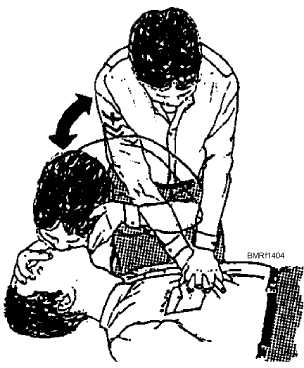When one rescuer performs CPR, as shown in
figure 14-4, the ratio of compressions to ventilations is
15 compressions to 2 ventilations (or 15 to 2). This ratio
must continue for four full cycles. Then check for pulse
and breathing. If there are still no signs of recovery,
continue CPR until the victim can breathe unassisted or
you are relieved by medical personnel.
Before reviewing the next technique, let’s go over
the steps to take in an unwitnessed cardiac arrest
involving one rescuer.
1. Determine whether the victim is conscious.
2. Check the vital signs.
3. Ventilate four times. (You may have to remove
an airway obstruction at this time.)
4. Again check the vital signs; if none—
a
Begin compression-ventilation rate of 15 to
2 for four complete cycles;
b. Check pulse, breathing, pupils; if no change,
c. Continue compression—ventilation rate of
15 to 2 until victim is responsive or you are
relieved by medical personnel.
TWO-RESCUER TECHNIQUE
If two people trained in CPR are on the scene, one
performs compressions while the other performs
artificial ventilation. The compression-ventilation ratio
for two-person CPR is 5 compressions to 1 ventilation
(5 to 1). One rescuer is positioned at the chest area and
the other beside the victim’s head. The rescuers should
be on opposite sides of the victim.
To avoid confusion, one rescuer is designated the
leader. The leader makes the preliminary checks of the
victim’s vital signs and performs the initial four
ventilations. The second rescuer will perform the
compressions.
When CPR is started, the compressions should be
given in a constant, methodical rhythm. The rescuer
giving the compressions counts them out loud. As the
fifth compression is released, the other rescuer
ventilates the victim. Do not stop the compressions
while ventilation is being given.
AIRWAY BLOCKAGE
Learning Objective: When you finish this chapter, you
will be able to—
Recall the procedures used to clear an airway
passage.
Obstruction in the upper airway (throat) is often
caused by attempting to chew food and talk at the same
time. One of the most reliable indications of an airway
obstruction is the inability of the victim to speak. Other
indicators are the victim’s grasping or pointing at his or
her throat, exaggerated breathing efforts, and the skin
turning a bluish color. Your first action upon
encountering a victim with this problem is to clear the
mouth of any food particles, foreign objects, or loose
dentures. If that is not effective, you should use one of
the following procedures:
14-6
Student Notes:
Figure 14-4.—One-rescuer CPR technique.

